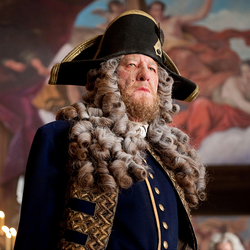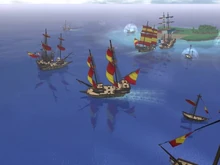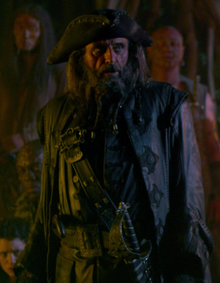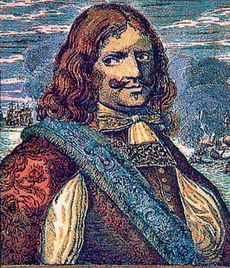No edit summary |
No edit summary |
||
| (28 intermediate revisions by 8 users not shown) | |||
| Line 1: | Line 1: | ||
| − | [[File: |
+ | [[File:Privateer.PNG|250px|thumb|[[Hector Barbossa]] served as a privateer for [[George II of Great Britain|King George II]] during the [[quest for the Fountain of Youth]].]] |
{{Quote|Full pardon, commission as a privateer on behalf of [[England]] and the [[East India Trading Company]]. As if I could be bought for such a low price.|[[Jack Sparrow]]|Pirates of the Caribbean: Dead Man's Chest}} |
{{Quote|Full pardon, commission as a privateer on behalf of [[England]] and the [[East India Trading Company]]. As if I could be bought for such a low price.|[[Jack Sparrow]]|Pirates of the Caribbean: Dead Man's Chest}} |
||
| + | A '''privateer''' was a person or [[ship]] authorized by a government by signed issued contracts, [[Letters of Marque]], to attack foreign shipping during wartime. Privateering allowed a pirate to become an agent of a government and become a "legitimate pirate" commissioned in service. Pirates were issued a "private license" by the government they side with, which grants the holder rights to attack the enemies of that government. It was a way of mobilizing armed ships and [[sailor]]s without having to spend treasury resources or commit naval officers and it gave pirates a way to commit piracy without fear of imprisonment. They could also be [[pardon]]ed from committing illicit things such as murder and rape. |
||
| − | |||
| − | A '''privateer''' was a man or a ship under contract to a government, allowing them to attack enemy ships of that government that has employed them. This contract, called a [[Letters of Marque|Letter of Marque]], meant that the government got a share of the profits in return for issuing it. |
||
==History== |
==History== |
||
| − | {{Quote|Hector. How nice to see a fellow pirate make good of himself."<br>"Pirate? Nay. Privateer. On a sanctioned mission, under the authority and protection of the Crown.|[[Jack Sparrow]] and [[Hector Barbossa]]|Pirates of the Caribbean: On Stranger Tides}} |
+ | {{Quote|Hector. How nice to see a fellow pirate make good of himself."<br>"Pirate? Nay. Privateer. On a sanctioned mission, under the authority and protection of the Crown.|[[Jack Sparrow]] and [[Hector Barbossa]]|Pirates of the Caribbean: On Stranger Tides}} |
| + | While the term "Privateer" was first documented in the 17th century, officially sanctioned [[pirate]]s had been around for centuries. Privateering allowed a pirate to become an agent of a government and become a "legitimate pirate" commissioned in service. Pirates were issued a "private license" by the government they side with, which granted the holder rights to attack the enemies of that government.<ref name="POTCO">''[[Pirates of the Caribbean Online]]''</ref> |
||
| ⚫ | Privateers were approved to attack hostile ships or forces to their commanding monarch(s) or |
||
| ⚫ | |||
| ⚫ | In the [[Golden Age of Piracy]], privateers were a large part of military forces at sea. Privateers were approved to attack hostile ships or forces to their commanding monarch(s), government, or private employer because of an issued contract, signed by the employer of that privateer. This contract, called a [[letters of marque]], meant that the employer got a share of the profits in return for issuing it (usually one-fifth of the value of the captured ship and cargo).<ref name=>''[[The Captain Jack Sparrow Handbook]]'', p27</ref> |
||
| ⚫ | |||
These contracts were originally called "''Letters of Marque and Reprisal''" and issued directly by monarchs and governments, but by the late 17th century they were issued by appointed government officials, and later by colonial [[governor]]s. |
These contracts were originally called "''Letters of Marque and Reprisal''" and issued directly by monarchs and governments, but by the late 17th century they were issued by appointed government officials, and later by colonial [[governor]]s. |
||
| + | |||
| + | The term privateer could refer any of the crew members, the captain, or the ship commanded. The ships could also be referred to as private [[man-of-war|men-of-war]]. |
||
Privateering is often described as a form of "legal" [[piracy]]. Strictly, a privateer was only entitled to attack enemy vessels, not any vessel, as illegal pirates would. However, states often encouraged attacks on opposing powers while at peace, or on neutral vessel during time of war, blurring the line between privateering and piracy. |
Privateering is often described as a form of "legal" [[piracy]]. Strictly, a privateer was only entitled to attack enemy vessels, not any vessel, as illegal pirates would. However, states often encouraged attacks on opposing powers while at peace, or on neutral vessel during time of war, blurring the line between privateering and piracy. |
||
| + | Privateer ships were generally run very loosely. Spirits, gambling and fights were common, even if there were rules against them, particularly gambling. If a captured [[merchantman]] fails to produce enough profit from its cargo, privateers would sometimes go to robbing passengers which were usually present, while rape and ill-use were also some of the more regretful traits. |
||
| − | Many members of the [[Cursed crew]] were privateers before peace-time saw the loss of their employment, forcing them to turn to piracy<ref name=>[[Pirates of the Caribbean: The Visual Guide]], p34-35: "The Cursed Crew"</ref>. During the [[War Against Piracy]], [[Lord]] [[Cutler Beckett]] attempted to employ [[Jack Sparrow]] as a privateer with the use of the [[Letters of Marque]], but they were ultimately claimed by [[James Norrington]]<ref name=>[[Pirates of the Caribbean: Dead Man's Chest]]</ref>. |
||
| + | [[File:BB3.PNG|220px|thumb|[[Edward Teach]] was a privateer before he turned to piracy.]] |
||
| + | During the War for the Spanish Succession, the Englishman [[Edward Teach]] fought as a privateer for [[Great Britain]]. When the war ended, [[King]] [[George I of Great Britain|George]] decided to withdraw all [[Letters of Marque]], and Teach became the infamous pirate known as [[Blackbeard]].<ref name="WDPOTC">''[[Walt Disney's Pirates of the Caribbean: The Story of the Robust Adventure in Disneyland and Walt Disney World]]'', p13.</ref><ref name=>''[[The Captain Jack Sparrow Handbook]]'', p30</ref> The notorious pirate [[Calico Jack Rackham]] and his associates [[Mary Read]] and [[Anne Bonny]] were captured in 1720 by a group of English privateers.<ref name=>''[[The Captain Jack Sparrow Handbook]]'', p34</ref> Many members of the [[cursed crew]] were privateers before peace-time saw the loss of their employment, forcing them to turn to piracy.<ref name=>''[[Pirates of the Caribbean: The Visual Guide]]'', p34-35: "The Cursed Crew"</ref> Before the [[War Against Piracy]], [[Lord]] [[Cutler Beckett]] attempted to employ [[Jack Sparrow]] as a privateer with the use of [[Cutler Beckett's Letters of Marque|Letters of Marque]], but they were ultimately claimed by [[James Norrington]].<ref name=>''[[Pirates of the Caribbean: Dead Man's Chest]]''</ref> |
||
| − | + | At some point after the war, [[Hector Barbossa]] received a [[Royal Pardon]], becoming an ex-pirate and privateer in the employ of [[King]] [[George II of Great Britain|George II]].<ref name=>''[[Pirates of the Caribbean: On Stranger Tides: The Visual Guide]]'', p45.</ref> Confident and persuasive, Barbossa had won the trust of the British Crown with a departure from his past pirate ways and a new respect for authority.<ref name="OSTVisualBritish">''[[Pirates of the Caribbean: On Stranger Tides: The Visual Guide]]'', p14-15: "The British"</ref> Although he had shown loyalty to King George, his appearance as a "reformed pirate" was only part of his plan to get revenge on [[Blackbeard]], the infamous pirate who cost him the ''[[Black Pearl]]'' and his right leg.<ref name="OSTVisualBarbossa">''[[Pirates of the Caribbean: On Stranger Tides: The Visual Guide]]'', p16-17 "Hector Barbossa"</ref> By the [[Quest for the Fountain of Youth|quest]] for the [[Fountain of Youth]], Barbossa was captain of the [[HMS Providence|HMS ''Providence'']]. Prior to the voyage, Barbossa recruited pirate [[Joshamee Gibbs]], who was once a sailor in the [[British Royal Navy|Royal Navy]]. After the quest, having defeated Blackbeard and claimed his [[Sword of Triton|sword]] and [[Queen Anne's Revenge|ship]], Barbossa tore up [[Hector Barbossa's Letter of Marque|his Letters of Marque]] and returned to piracy once again.<ref name="OST">''[[Pirates of the Caribbean: On Stranger Tides]]''</ref> |
|
== Notable privateers == |
== Notable privateers == |
||
| − | {{Quote|Be a gem, and pour me a gulper?"<br>"Nay! We be privateers, not pirates, Master Gibbs |
+ | {{Quote|Be a gem, and pour me a gulper?"<br>"Nay! We be privateers, not pirates, Master Gibbs. And in the King's name, will behave as such.|[[Joshamee Gibbs]] and [[Hector Barbossa]]|Pirates of the Caribbean: On Stranger Tides}}[[File:Henry Morgan.gif|thumb|230px|[[Sir]] [[Henry Morgan]], a notorious privateer of the 17th century.]] |
| − | [[File:Henry Morgan.gif|thumb|235px|[[Sir]] [[Henry Morgan]], the most notorious privateer of the 17th century]] |
||
Note most pirates were originally privateers. |
Note most pirates were originally privateers. |
||
| − | *[[Henry Morgan]] (on behalf of [[England]] [1663-1671]) |
+ | *[[Henry Morgan]] (on behalf of [[England]] [1663-1671])<ref>''[[The Captain Jack Sparrow Handbook]]'', p31</ref> |
| − | *[[Blackbeard|Edward Teach]] (on behalf of [[England]]/[[Great Britain]] [1701-1714]) |
+ | *[[Blackbeard|Edward Teach]] (on behalf of [[England]]/[[Great Britain]] [1701-1714])<ref>''[[The Captain Jack Sparrow Handbook]]'', p30</ref> |
| − | *[[Ammand the Corsair]] (on behalf of [[Ottoman Empire]]) |
+ | *[[Ammand|Ammand the Corsair]] (on behalf of the [[Ottoman Empire]])<ref>[http://disney.go.com/disneypictures/pirates/atworldsend/maptimeline/ Pirates of the Caribbean: At World's End: Pirate Lords Map]</ref> |
*[[Eduardo Villanueva]] (on behalf of [[Spain]]) |
*[[Eduardo Villanueva]] (on behalf of [[Spain]]) |
||
| − | *[[Garcia de |
+ | *[[Garcia de la Avaricia]] (on behalf of [[Spain]])<ref name="POTCO"/> |
| − | *[[Unnamed Spanish privateer]] (on behalf of [[Spain]]) |
+ | *[[Unnamed Spanish privateer]] (on behalf of [[Spain]])<ref name="POTCO"/> |
| − | *[[Pierre le Porc]] (on behalf of [[France]]) |
+ | *[[Pierre le Porc]] (on behalf of [[France]])<ref name="POTCO"/> |
| − | *[[Hector Barbossa]] (on behalf of [[Great Britain]] [1750]) |
+ | *[[Hector Barbossa]] (on behalf of [[Great Britain]] [1750])<ref name="OST"/> |
== Behind the scenes == |
== Behind the scenes == |
||
| + | {{Quote|I take it I've won comission as a privateer?"<br>"Oh I think... better!|[[James Norrington]] and [[Cutler Beckett]]|Pirates of the Caribbean: Dead Man's Chest|other=deleted scene}} |
||
| + | *In a [[Pirates of the Caribbean: Dead Man's Chest/Deleted scenes|deleted scene]] in ''[[Pirates of the Caribbean: Dead Man's Chest|Dead Man's Chest]]'' when [[James Norrington]] gives the [[Heart of Davy Jones]] to [[Cutler Beckett]] he asks if he has won comission as a privateer, to which a satisfied Beckett responds by reinstating him to his old rank and status and promoting him to the rank of [[admiral]]. |
||
*In ''[[Pirates of the Caribbean Online]]'' there are several items named after privateers. A [[w:c:piratesonline:Privateer's Bayonet|Bayonet]], a [[w:c:piratesonline:Privateer's Sea Globe|Sea Globe]], a [[w:c:piratesonline:Privateer's Cutlass|Cutlass]], and a [[Voodoo]] [[w:c:piratesonline:Privateer Doll|Doll]]. |
*In ''[[Pirates of the Caribbean Online]]'' there are several items named after privateers. A [[w:c:piratesonline:Privateer's Bayonet|Bayonet]], a [[w:c:piratesonline:Privateer's Sea Globe|Sea Globe]], a [[w:c:piratesonline:Privateer's Cutlass|Cutlass]], and a [[Voodoo]] [[w:c:piratesonline:Privateer Doll|Doll]]. |
||
| + | |||
| + | ==Appearances== |
||
| + | *''[[Jack Sparrow: The Timekeeper]]'' {{Mo}} |
||
| + | *''[[Legends of the Brethren Court: Day of the Shadow]]'' {{Mo}} |
||
| + | *''[[Pirates of the Caribbean Online]]'' {{1st}} |
||
| + | *''[[Pirates of the Caribbean: Dead Man's Chest]]'' {{1stm}} |
||
| + | *''[[Pirates of the Caribbean: On Stranger Tides]]'' |
||
| + | *''[[LEGO Pirates of the Caribbean: The Video Game]]'' {{Nc}} |
||
| + | |||
| + | ==Sources== |
||
| + | *''[[Pirates of the Caribbean (film series)]]'' |
||
| + | *''[[Pirates of the Caribbean: The Visual Guide]]'' |
||
| + | *''[[Pirates of the Caribbean: The Complete Visual Guide]]'' |
||
| + | *''[[The Captain Jack Sparrow Handbook]]'' |
||
| + | *''[[Pirates of the Caribbean: On Stranger Tides: The Visual Guide]]'' |
||
==External links== |
==External links== |
||
| Line 38: | Line 58: | ||
==Notes and references== |
==Notes and references== |
||
| − | {{Reflist |
+ | {{Reflist}} |
| − | [[ |
+ | [[de:Freibeuter]] |
| − | [[Category: |
+ | [[Category:Privateers| ]] |
| − | [[Category: |
+ | [[Category:British Royal Navy]] |
| + | [[Category:French Royal Navy]] |
||
[[Category:Spanish Royal Navy]] |
[[Category:Spanish Royal Navy]] |
||
[[Category:Piracy]] |
[[Category:Piracy]] |
||
Revision as of 20:41, 24 February 2020

Hector Barbossa served as a privateer for King George II during the quest for the Fountain of Youth.
- "Full pardon, commission as a privateer on behalf of England and the East India Trading Company. As if I could be bought for such a low price."
- ―Jack Sparrow
A privateer was a person or ship authorized by a government by signed issued contracts, Letters of Marque, to attack foreign shipping during wartime. Privateering allowed a pirate to become an agent of a government and become a "legitimate pirate" commissioned in service. Pirates were issued a "private license" by the government they side with, which grants the holder rights to attack the enemies of that government. It was a way of mobilizing armed ships and sailors without having to spend treasury resources or commit naval officers and it gave pirates a way to commit piracy without fear of imprisonment. They could also be pardoned from committing illicit things such as murder and rape.
History
- "Hector. How nice to see a fellow pirate make good of himself."
"Pirate? Nay. Privateer. On a sanctioned mission, under the authority and protection of the Crown." - ―Jack Sparrow and Hector Barbossa
While the term "Privateer" was first documented in the 17th century, officially sanctioned pirates had been around for centuries. Privateering allowed a pirate to become an agent of a government and become a "legitimate pirate" commissioned in service. Pirates were issued a "private license" by the government they side with, which granted the holder rights to attack the enemies of that government.[1]
In the Golden Age of Piracy, privateers were a large part of military forces at sea. Privateers were approved to attack hostile ships or forces to their commanding monarch(s), government, or private employer because of an issued contract, signed by the employer of that privateer. This contract, called a letters of marque, meant that the employer got a share of the profits in return for issuing it (usually one-fifth of the value of the captured ship and cargo).[2]

A battle between the French and the Spanish privateers.
These contracts were originally called "Letters of Marque and Reprisal" and issued directly by monarchs and governments, but by the late 17th century they were issued by appointed government officials, and later by colonial governors.
The term privateer could refer any of the crew members, the captain, or the ship commanded. The ships could also be referred to as private men-of-war.
Privateering is often described as a form of "legal" piracy. Strictly, a privateer was only entitled to attack enemy vessels, not any vessel, as illegal pirates would. However, states often encouraged attacks on opposing powers while at peace, or on neutral vessel during time of war, blurring the line between privateering and piracy.
Privateer ships were generally run very loosely. Spirits, gambling and fights were common, even if there were rules against them, particularly gambling. If a captured merchantman fails to produce enough profit from its cargo, privateers would sometimes go to robbing passengers which were usually present, while rape and ill-use were also some of the more regretful traits.

Edward Teach was a privateer before he turned to piracy.
During the War for the Spanish Succession, the Englishman Edward Teach fought as a privateer for Great Britain. When the war ended, King George decided to withdraw all Letters of Marque, and Teach became the infamous pirate known as Blackbeard.[3][4] The notorious pirate Calico Jack Rackham and his associates Mary Read and Anne Bonny were captured in 1720 by a group of English privateers.[5] Many members of the cursed crew were privateers before peace-time saw the loss of their employment, forcing them to turn to piracy.[6] Before the War Against Piracy, Lord Cutler Beckett attempted to employ Jack Sparrow as a privateer with the use of Letters of Marque, but they were ultimately claimed by James Norrington.[7]
At some point after the war, Hector Barbossa received a Royal Pardon, becoming an ex-pirate and privateer in the employ of King George II.[8] Confident and persuasive, Barbossa had won the trust of the British Crown with a departure from his past pirate ways and a new respect for authority.[9] Although he had shown loyalty to King George, his appearance as a "reformed pirate" was only part of his plan to get revenge on Blackbeard, the infamous pirate who cost him the Black Pearl and his right leg.[10] By the quest for the Fountain of Youth, Barbossa was captain of the HMS Providence. Prior to the voyage, Barbossa recruited pirate Joshamee Gibbs, who was once a sailor in the Royal Navy. After the quest, having defeated Blackbeard and claimed his sword and ship, Barbossa tore up his Letters of Marque and returned to piracy once again.[11]
Notable privateers
- "Be a gem, and pour me a gulper?"
"Nay! We be privateers, not pirates, Master Gibbs. And in the King's name, will behave as such." - ―Joshamee Gibbs and Hector Barbossa

Sir Henry Morgan, a notorious privateer of the 17th century.
Note most pirates were originally privateers.
- Henry Morgan (on behalf of England [1663-1671])[12]
- Edward Teach (on behalf of England/Great Britain [1701-1714])[13]
- Ammand the Corsair (on behalf of the Ottoman Empire)[14]
- Eduardo Villanueva (on behalf of Spain)
- Garcia de la Avaricia (on behalf of Spain)[1]
- Unnamed Spanish privateer (on behalf of Spain)[1]
- Pierre le Porc (on behalf of France)[1]
- Hector Barbossa (on behalf of Great Britain [1750])[11]
Behind the scenes
- "I take it I've won comission as a privateer?"
"Oh I think... better!" - ―James Norrington and Cutler Beckett
- In a deleted scene in Dead Man's Chest when James Norrington gives the Heart of Davy Jones to Cutler Beckett he asks if he has won comission as a privateer, to which a satisfied Beckett responds by reinstating him to his old rank and status and promoting him to the rank of admiral.
- In Pirates of the Caribbean Online there are several items named after privateers. A Bayonet, a Sea Globe, a Cutlass, and a Voodoo Doll.
Appearances
- Jack Sparrow: The Timekeeper (Mentioned only)
- Legends of the Brethren Court: Day of the Shadow (Mentioned only)
- Pirates of the Caribbean Online (First appearance)
- Pirates of the Caribbean: Dead Man's Chest (First mentioned)
- Pirates of the Caribbean: On Stranger Tides
- LEGO Pirates of the Caribbean: The Video Game (Non-canonical appearance)
Sources
- Pirates of the Caribbean (film series)
- Pirates of the Caribbean: The Visual Guide
- Pirates of the Caribbean: The Complete Visual Guide
- The Captain Jack Sparrow Handbook
- Pirates of the Caribbean: On Stranger Tides: The Visual Guide
External links
Notes and references
- ↑ 1.0 1.1 1.2 1.3 Pirates of the Caribbean Online
- ↑ The Captain Jack Sparrow Handbook, p27
- ↑ Walt Disney's Pirates of the Caribbean: The Story of the Robust Adventure in Disneyland and Walt Disney World, p13.
- ↑ The Captain Jack Sparrow Handbook, p30
- ↑ The Captain Jack Sparrow Handbook, p34
- ↑ Pirates of the Caribbean: The Visual Guide, p34-35: "The Cursed Crew"
- ↑ Pirates of the Caribbean: Dead Man's Chest
- ↑ Pirates of the Caribbean: On Stranger Tides: The Visual Guide, p45.
- ↑ Pirates of the Caribbean: On Stranger Tides: The Visual Guide, p14-15: "The British"
- ↑ Pirates of the Caribbean: On Stranger Tides: The Visual Guide, p16-17 "Hector Barbossa"
- ↑ 11.0 11.1 Pirates of the Caribbean: On Stranger Tides
- ↑ The Captain Jack Sparrow Handbook, p31
- ↑ The Captain Jack Sparrow Handbook, p30
- ↑ Pirates of the Caribbean: At World's End: Pirate Lords Map
